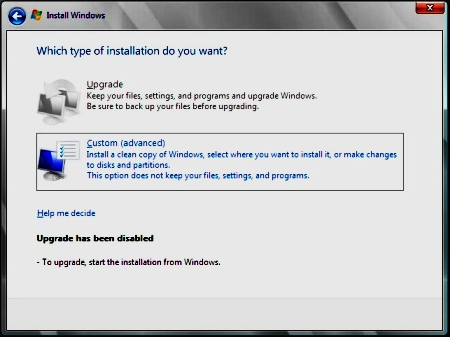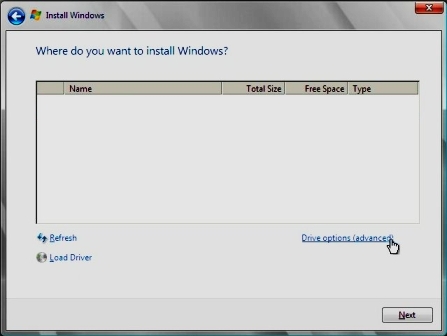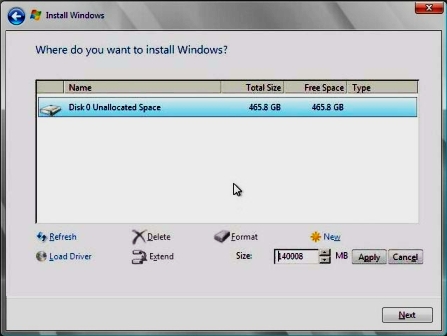Install Windows Server 2008 R2 (Manually)
This section describes how to install Windows Server 2008 R2 without the use of Oracle System Assistant. The OS can be installed using either a local or remote method.
 | Caution - Possible data loss. The OS installation formats the boot disk, which erases any existing data on the disk, including any preinstalled OS. |
Before You Begin
-
Obtain the Microsoft Windows OS installation distribution media.
Create a bootable virtual drive (with at least RAID 0) if your system has a Sun Storage 6 Gb SAS PCIe RAID Internal HBA (SGX-SAS6-R-INT-Z). For details, see Configure RAID With a Sun Storage 6 Gb SAS PCIe RAID Internal HBA in Sun Server X4-4 Installation Guide.
-
Prepare for a local or remote installation as described in Setting Up the Installation Method. Then perform one of the following:
-
For local installation: Have the OS distribution media available to insert into the attached physical CD/DVD-ROM drive.
-
For remote installation:
-
If your OS distribution media is a DVD-ROM, insert it into the remote client's DVD-ROM drive and mount it through the Oracle ILOM Remote Console KVMS -> Storage menu.
-
If you are using an ISO image of the OS distribution media, ensure that the image is mounted through the Oracle ILOM Remote Console KVMS -> Storage menu.
-
-
- Power on or reboot the server.
If you are using the remote installation method, you can power on or reboot the server through Oracle ILOM.
BIOS messages appear.

-
Watch the screen until you see a list of selections and then press F8 to select BBS
Popup.
Note - BIOS messages, including the BIOS menu selection list, can go by quickly. If you miss the messages, power cycle the server and hold down the F8 key during boot until the BBS Popup menu appears.After a delay, a Select Boot Device menu appears with a list of possible boot devices.
-
Select a boot device from the list, as follows:
-
For a local installation, insert the Windows distribution media into the server's CD/DVD drive, select it from the list of devices and press Enter.
-
For a remote installation, select the client's remotely mounted virtual CD/DVD drive and press Enter.
Note - Make sure that the boot entry for the Oracle System Assistant USB is below the hard disk on which you want to install the OS. This ordering can be set using the system BIOS Setup Utility.Control passes to the OS installation program on the media.
-
- When prompted with Press any key to boot from CD, quickly press any
key.
The Windows installation wizard starts.
- Proceed through the installation wizard until you see the Installation Type screen, then click
Custom (advanced).

- At the Where Do You Want to Install Windows screen, perform one of the following
procedures:
To add a mass storage driver for Windows Server 2008 R2, click Load Driver, browse to the location of the mass storage device driver (CD/DVD or USB flash drive), and select the driver information file (.inf).
Note - For Windows Server 2008 R2, the driver must be accessible through a connected CD/DVD or the Oracle System Assistant USB flash drive. If the driver is not accessible, the disk is not visible as shown below.To select the Windows default partition settings, click Next. Go to Step 8.
To override the Windows default partition settings, click Drive Options (advanced) and proceed to the next step.


Caution - Possible data loss. Formatting or repartitioning a preexisting partition destroys all data on the partition.
- At the Advanced Drive Options screen:
- To delete the existing partition, click Delete.
- To create the new partition, click New.
- Change size settings as needed, and then click Apply.
- Click Next.

The Windows installation begins. During the installation process, the server reboots several times.
- When the installation process is complete, click OK.
Windows starts and prompts you for an administrator password.
-
Enter a password and click OK.
Note - The password must have 8 characters, with one number and one uppercase character. For more details, click the Accessibility link on the account creation screen.Once you have assigned a password to the Administrator account, the Windows Server 2008 R2 desktop appears.
See Also
Installing Server System Tools, Updating Drivers, and Setting Up iSCSI Virtual Disks